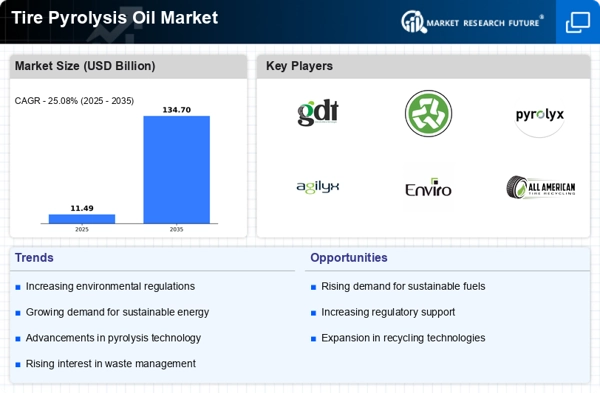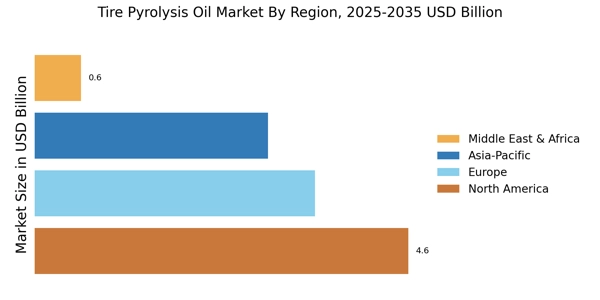Rising Environmental Concerns
The Tire Pyrolysis Oil Market is significantly influenced by rising environmental concerns associated with waste management. The accumulation of used tires poses a substantial environmental challenge, leading to pollution and health hazards. Tire pyrolysis offers an effective solution by converting waste tires into valuable products, including oil, carbon black, and gas. This process not only mitigates the environmental impact of tire disposal but also contributes to resource recovery. As awareness of environmental issues grows, industries are increasingly seeking sustainable waste management solutions. The tire pyrolysis oil market is expected to benefit from this trend, as companies and governments prioritize eco-friendly practices. The potential to reduce landfill waste and lower greenhouse gas emissions positions tire pyrolysis oil as a crucial component in addressing environmental challenges, thereby driving market growth.
Supportive Regulatory Frameworks
The Tire Pyrolysis Oil Market benefits from supportive regulatory frameworks that encourage the adoption of waste-to-energy technologies. Governments are increasingly implementing policies aimed at promoting sustainable waste management practices, including the use of tire pyrolysis. Incentives such as tax breaks, grants, and subsidies for companies investing in pyrolysis technology are becoming more common. These regulatory measures not only facilitate market entry for new players but also stimulate innovation within the industry. As regulations become more stringent regarding waste disposal and emissions, the demand for tire pyrolysis oil is likely to rise. The alignment of regulatory support with environmental goals creates a favorable environment for the growth of the tire pyrolysis oil market, as stakeholders seek compliant and sustainable solutions to waste management.
Increasing Demand for Renewable Energy Sources
The Tire Pyrolysis Oil Market is experiencing a notable surge in demand for renewable energy sources. As nations strive to reduce their carbon footprints, the emphasis on sustainable energy solutions has intensified. Tire pyrolysis oil, derived from waste tires, presents a viable alternative to fossil fuels, aligning with global energy transition goals. The market for tire pyrolysis oil is projected to grow at a compound annual growth rate of approximately 7% over the next five years, driven by the increasing adoption of renewable energy technologies. This trend indicates a shift towards cleaner energy sources, positioning tire pyrolysis oil as a key player in the renewable energy landscape. Furthermore, the potential for tire pyrolysis oil to be utilized in various applications, including power generation and as a feedstock for petrochemical industries, enhances its attractiveness in the energy market.
Growing Industrial Applications of Pyrolysis Oil
The Tire Pyrolysis Oil Market is experiencing growth due to the expanding range of industrial applications for pyrolysis oil. This oil can be utilized as a substitute for traditional fuels in various sectors, including manufacturing, transportation, and energy generation. The versatility of tire pyrolysis oil makes it an attractive option for industries seeking to reduce their reliance on fossil fuels. Recent studies indicate that the use of pyrolysis oil in industrial boilers and engines can lead to significant cost savings and lower emissions. As industries increasingly prioritize sustainability and cost-effectiveness, the demand for tire pyrolysis oil is expected to rise. The potential for further research and development in this area may unlock new applications, thereby enhancing the market's growth prospects.
Technological Innovations in Pyrolysis Processes
The Tire Pyrolysis Oil Market is witnessing advancements in pyrolysis technologies that enhance efficiency and product yield. Innovations in reactor design, temperature control, and feedstock processing are contributing to more effective tire pyrolysis operations. These technological improvements not only increase the quantity of oil produced but also improve the quality of the end products. For instance, modern pyrolysis systems can achieve higher conversion rates, resulting in a more economically viable process. The market is projected to expand as these technologies become more accessible to manufacturers. Additionally, the integration of automation and real-time monitoring systems in pyrolysis plants is likely to optimize production processes, further driving the growth of the tire pyrolysis oil market. As companies adopt these innovations, the overall competitiveness of the industry is expected to improve, attracting more investments.


















Leave a Comment